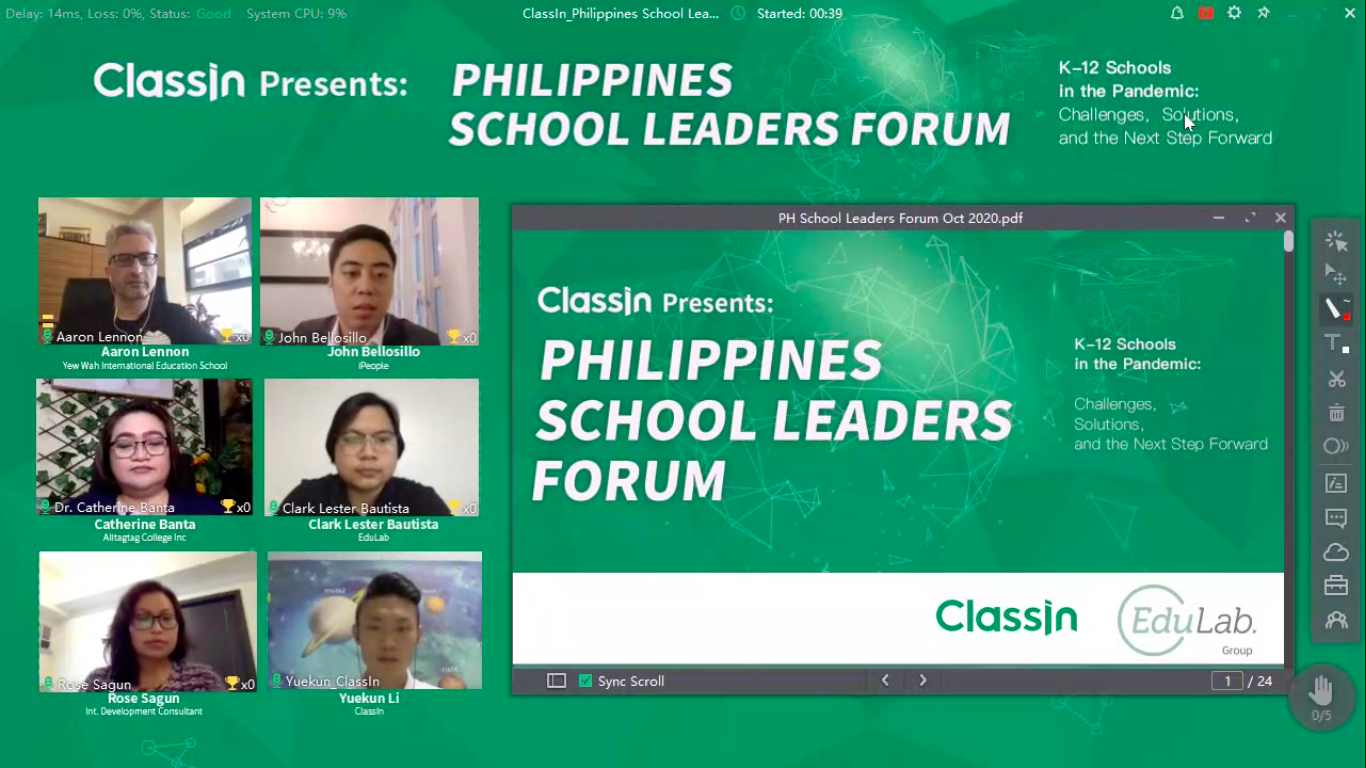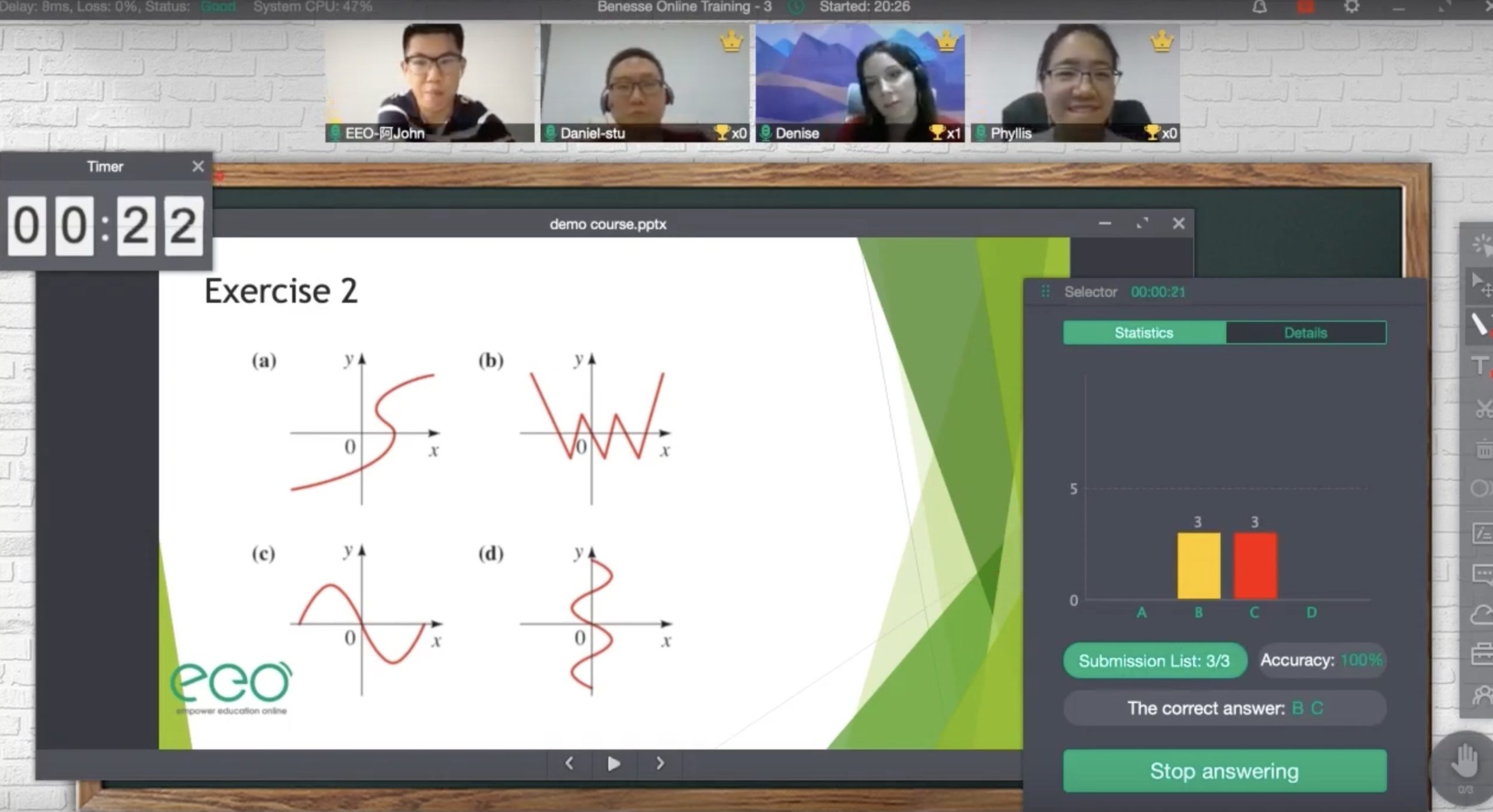The pandemic crisis has caused tectonic shifts in society and has forced even the education sector to do an extensive experimentation of new ideas and modalities of teaching. With face-to-face schooling currently at a standstill, can quality education still be provided? Are EdTech tools the solution to make the transition more friendly? To answer these questions, ClassIn—the world’s first ever online classroom—recently invited K-12 industry Thought Leaders, school presidents, and principals to discuss the current situation they are facing, the solutions they have employed, and the next steps forward for education in the post-pandemic era.
School Leaders Forum by ClassIn

Heading the School Leaders Forum is Yuekun Li, ClassIn Philippines Country Manager who works closely with educators in the country and help them formulate viable solutions to counter the rising challenges with the goal of making high quality educational resources available for schools in need.
Members of the panel were Aaron Lennon, co-Principal at Yew Wah International Education School in Guangzhou, China; John Bellosillo, Head of Dual Transformation Management of iPeople Inc. and Head of Planning National Teachers College; and Dr. Catherine Banta, a licensed medical doctor who is also the Chairman and President of Alitagtag College Inc, Batangas. Also, a key part of the panel were Rose Sagun, International Development Consultant for Learning and EdTech; and Clark Lester Bautista, VP for Business Development of EduLab Inc for India and Southeast Asia and CEO and Director of JIEM India Pvt. Ltd, a subsidiary of EduLab.

Maths class on ClassIn
ClassIn is a groundbreaking online teaching platform that enables teachers and students to come together online and learn in a collaborative virtual environment. With a shared, interactive blackboard, a suite of essential teaching tools, and a cloud service that allows easy access to teaching materials, ClassIn has everything educators need to create engaging classes online. Whether they are teaching ESL, Math, Science, Art, Music, Coding or offering professional development courses, ClassIn’s mission is to empower online education by providing teachers and institutions the platform they need to make online learning personal and engaging for the students.
Currently, ClassIn has over 60,000 partner schools and institutions and 20 million monthly active users from more than 150 countries like the UK, US, Italy, Brazil, Japan, Argentina, UAE, Spain, and now, the Philippines, successfully delivering 200,000,000+ class hours.
The Out-of-the-box Teaching Tool
ClassIn, according to Li, is providing support to help teachers, school administrators and students get back to the learning environment in the “new normal” in the Philippines until December 31, 2020, for free!
More than being just a teaching tool, ClassIn provides video conferencing as a base feature and likewise provides educators with an integrated, interactive virtual whiteboard so teachers can conduct their classes similar to face-to-face scenario that students have been used to. The built-in instruction tools such as the timer device, small blackboard, text collaborator, screen sharing, and an icon to raise hands, which involve typical activities in a classroom, help teachers create an engaging classroom environment where students will less likely see learning as a boring task.
“The web browser-based ClassIn dashboard method could help facilitate institutions administer their teachers, students, courses, and lessons in an inclusive and thorough manner. This means that the school can concentrate on planning for the semester before it starts, and once things are in working, lessons and courses’ procedures will be automated,” Li said.
Li noted that ClassIn was introduced to the Philippines through their reputation. “We were working with a Chinese-Philippine online ESL company where we were able to showcase our product to many teachers in the Philippines. The teachers loved their experiences conducting online classes using ClassIn and then referred us to the schools they are working at. Especially in a situation where ClassIn could really help make a difference for many PH schools, and that is how we built up our user base. In August 2020 alone, ClassIn’s usage in the PH increased over 10 times as we started supporting K-12 schools with our services,” he said.
Alitagtag College Inc. in Batangas was the first ever learning institution to make use of ClassIn. Dr. Banta can attest to how ClassIn has improved their mode of teaching. “I first heard about ClassIn from my son, a former ESL tutor whose company uses ClassIn for teaching. For me, only ClassIn fit the design of Alitagtag College, and the company gave us training and support, 24/7,” Dr. Banta explained. According to her, even the students enjoy ClassIn it provides 50 virtual blackboards and breakout rooms for group activities. “The acceptance is overwhelming among teachers and students. ClassIn has a message box where our students can actually ask questions in a chat box and provide a lot of free solutions for schools lacking in funding, plus they have made our learning institution ready for the ever-changing education landscape,” Dra. Banta added.
The challenges of a good online teaching tool
Online learning particularly here in the Philippines is not easy, according to Bellosillo and Sagun, since there are inequities that exist, like the usability of the infrastructure vis-à-vis the different realities regarding readiness and connectivity. “How much will an average family spend for data and the apps; we know some parents lost their jobs because of the crisis. So that’s where the question comes in. EdTech tools should be fun and engaging; it should help teachers transform their roles and mindset, easy to use, easy to learn, and light in the pocket,” Bellosillo mused.
The shift from face-to-face classroom setting to virtual learning is tough and the challenges are numerous, but the panel was unanimous in claiming that ClassIn has greatly helped lighten the load. “Because of the situation, we were forced to do things very quickly, and obviously we were not prepared. But ClassIn gave us this ideal alternative where we decide to get creative about how our online classes will appeal or look like. It’s user-friendly both to teachers and students,” Lennon said. He also added that good online education should be synchronous and high quality so students get more engaged, and teachers are more comfortable with the online tools.
The quality of a good online learning is defined not only by what the students are learning but if the students are really learning, or if the virtual modules are interesting and interactive, and if the students really enjoy given this depressing pandemic. Dr. Banta pointed out how ClassIn was built with Action and Feedback, which allows for real time correction and mindful wellness which she said, she uses to talk to her students so that their mental health is considered as well.
“We are naturally born social animals and with the lockdown, students do not get to see their friends and share peer-to-peer activities. ClassIn provides functionally designed feedback tools that enables us to understand our students individually via a social-emotional education addressed by a synchronous, real time platform,” Lennon explained. Bautista agreed saying that ClassIn’s advantage is its Assessment Component, making way for adaptive teaching that results to adaptive learning experience.
ClassIn is outfitted with state-of-the-art online classroom tools that enable teachers and learners to prepare, review, and teach lessons on one platform; conduct quizzes with interactive tools like an answer sheet, a selector, a buzzer, a timer, and even a dice; conduct recitation with incentives like trophies for kids, share an collaborative e-blackboard which multiple users can write on; take class notes; and submit tasks. Apart from that, it can likewise complete lectures powered by multi-directional screen sharing; edit documents; and communicate via Instant Messaging. What gives ClassIn the edge is the roughly 44 learning behavior data readily available on the platform for teachers and students to work with as they educate and study virtually. It provides multiple scenario support from one-on-one classes, small, to large classes and can employ double teacher classroom and web-based live broadcast.
“Online tools have been there even before the pandemic and technology in education has been helping a lot of people over the past 10 to 20 years. The difference is right now, the technology is forced to the people. And the only way the transition can be done more friendly is for the educators and students to use it. There will definitely be a learning curve—and both teachers and students can flatten this curve by making themselves familiar with the tool,” Bautista noted.
The future of EdTech
“This pandemic showed us how important technology is. If there is one thing this crisis will contribute to the education industry, it is to make it realize that technology will provide educators tools to make teaching/learning better and more efficient in case of adaptive testing or learning where results are individually tailored to student so teacher can really pinpoint what student understands or does not understand,” Bautista added.
As educators are embracing the symbiotic relationship between education and technology, seeing great value in using digital learning tools like ClassIn in the virtual classroom and most of them digital learning tools are more effective for personalizing instruction, with a large majority plans to utilize and blend online-offline teaching as a more effective and engaging mode of teaching and learning.
“We all look forward to a successful virtual mode of teaching and learning and hopefully we could address the access inequality both in the national and local level. There should be a dynamic ecosystem for educators and students through research and development so that we could contribute to education technology across geographic location. There should also be data gathering about which schools are low to medium income and need help, so that we can harness technology to be inclusive. EdTech is here to stay,” Sagun stated.
It is said that each step of education greatly depends on the effort of every generation. Thus, even in the post-pandemic era, EdTech solution providers like ClassIn will continue to enhance the remote learning experiences of K-12 students, being the next generation interactive online focused on improving the quality of online teaching. And as teachers and students alike navigate what post-Covid new normal education will look like, they all believe that the future of EdTech is not only about its technology, but more about empowering education from Kinder through Ph.D, similar to what ClassIn has begun.
Learning beyond boundaries, as ClassIn espouses, means that everyone gets to teach and learn—no matter what race, culture, gender, income bracket, age, and in any circumstance—with virtually endless options that will shape their future, and benefit us all.
INQUIRER.net/JC
advt.

